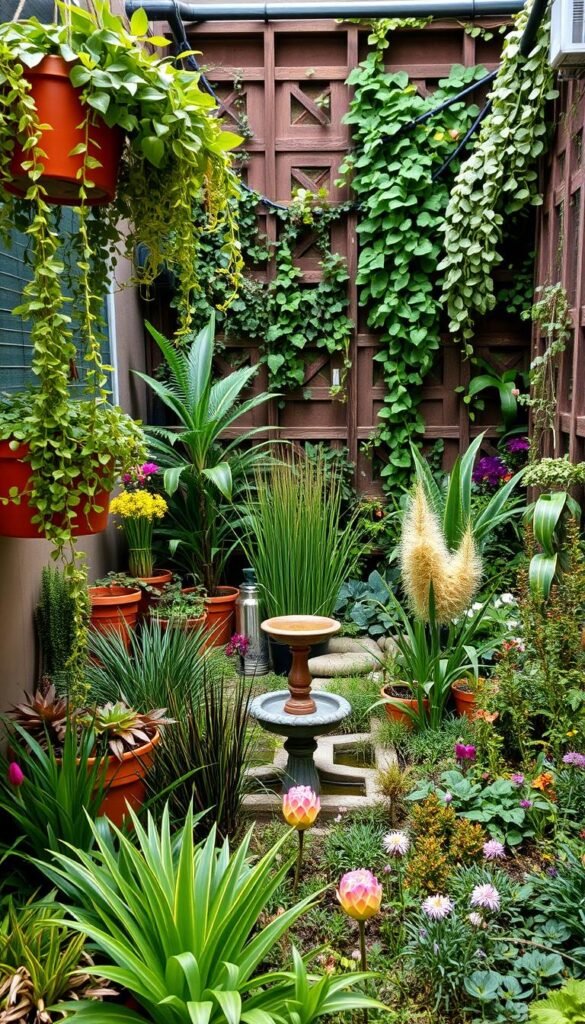Does your outdoor area feel more cramped than captivating? Think again. Even the coziest patios, balconies, or narrow side yards hold surprising potential when approached with smart design strategies. With thoughtful planning, you can cultivate an inviting green sanctuary that punches above its weight class.
Vertical solutions like wall planters and hanging baskets become your best friends in tight quarters. Pair these with compact containers arranged in tiered groupings to add depth and visual interest. For those craving fresh flavors, herb spirals or square-foot gardening techniques let you grow impressive yields in just 4×4 feet of space.
Professional designers achieve big impact through clever illusions. Mirrors create perceived depth, while curved pathways draw the eye forward. Dwarf fruit trees and bush vegetables like determinate tomatoes prove good things come in small packages – some varieties thrive in 24-inch pots!
Your secret weapon? Multi-functional elements. A bench with built-in storage holds tools while serving as seating. Repurposed ladders become plant stands, and old pallets transform into vertical herb walls. Focus on plants offering triple-duty benefits – beauty, fragrance, and edibility – to maximize every inch.
Season extension tricks like DIY cold frames (costing as little as $20) let you enjoy fresh greens longer. By combining these approaches, you’ll create a personalized oasis that feels expansive yet intimate – proof that limited square footage can’t limit your creativity.
Essential Principles for a Thriving Mini Garden
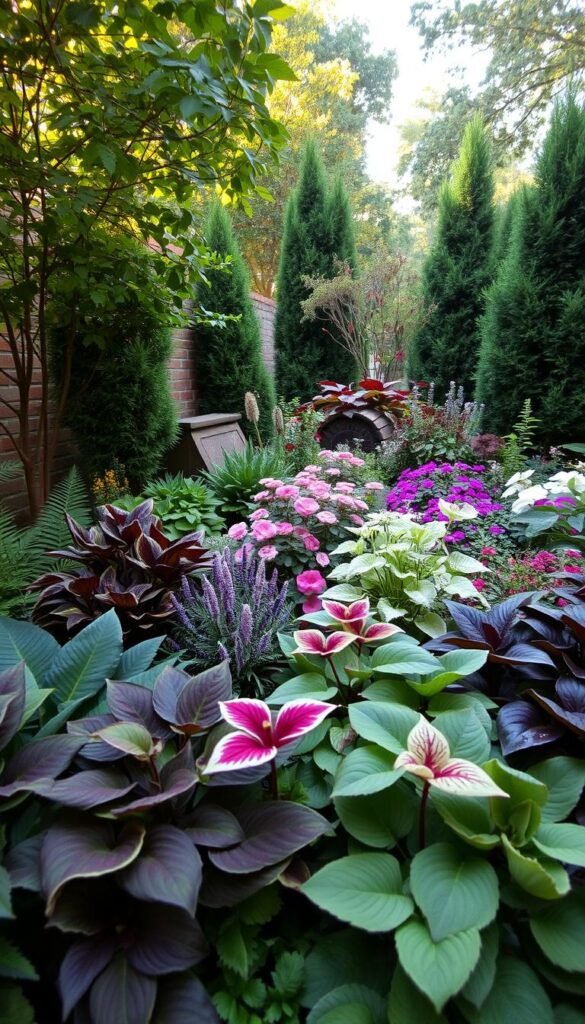
Transform your pint-sized plot into a lush retreat with these design-smart strategies. Balance proves critical – aim for equal parts greenery and functional surfaces like seating or pathways. This 50/50 split keeps your space feeling open yet abundant.
Selecting a Cohesive Planting Palette
Limit your plant varieties to three key colors and textures for instant polish. Repeating purple sage along walkways or clusters of dwarf hydrangeas creates rhythm. Multi-season performers like ornamental grasses extend visual interest from spring through fall.
Choose specimens that earn their keep. Lavender offers fragrance and pollinator appeal, while compact blueberry bushes provide snacks and scarlet autumn foliage. Avoid spreaders that bully neighbors – stick to well-behaved varieties that respect boundaries.
Maximizing Your Limited Outdoor Space
Think vertically with wall-mounted planters for herbs or trailing ivy. Layer containers at different heights using stools or shelves to create depth. A repurposed ladder becomes an instant plant stand, doubling as living art against fences.
Match your plant choices to the garden’s purpose. Edible flowers like nasturtiums brighten salads while softening hard edges. For modern spaces, architectural succulents in geometric pots make striking focal points without crowding.
Designing Your Outdoor Space for Maximum Impact
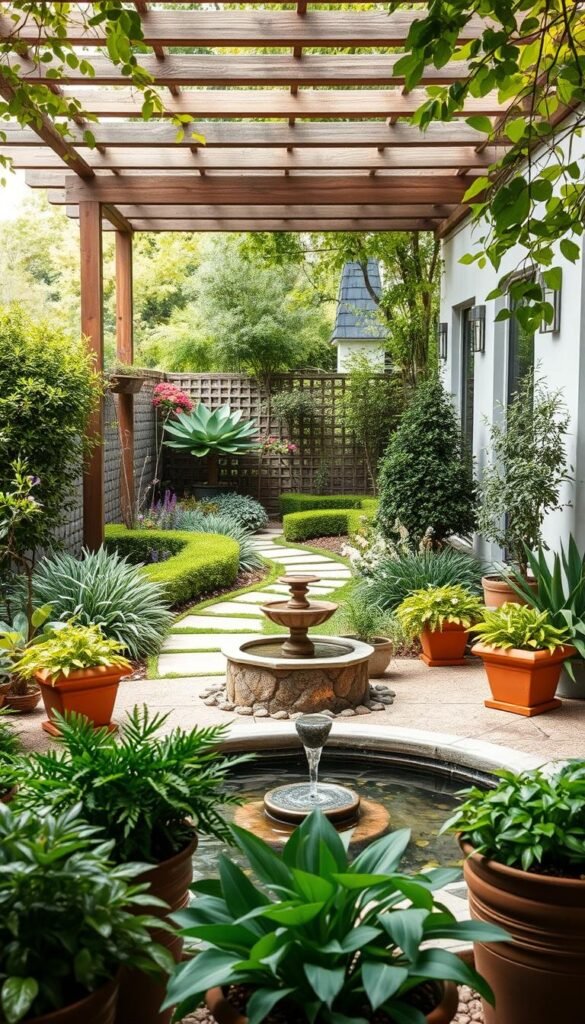
Unlock hidden potential in your cozy yard by mastering the art of visual storytelling. Clever spatial tricks can make even modest outdoor space feel expansive and layered. Start by dividing your layout into distinct functional zones – a trick professional designers use to add intrigue and depth.
Create natural boundaries using low boxwood hedges or decorative metal screens. These partitions guide exploration while hiding the full scope of your design, making areas feel larger. Pair this approach with light-reflecting materials like pale stone pavers or whitewashed planters to amplify brightness in shady spots.
Curved pathways lined with lavender or ornamental grasses soften edges and invite curiosity. For vertical layers, try this arrangement:
| Height Tier | Plant Examples | Visual Effect |
|---|---|---|
| Back (Tallest) | Bamboo screens, climbing roses | Creates privacy backdrop |
| Middle | Dwarf hydrangeas, Russian sage | Adds mid-level texture |
| Front | Creeping thyme, sedum | Softens hardscapes |
Warm string lights or solar lanterns extend usability into evenings while maintaining airy ambiance. For creative gardening ideas, focus on one showstopper like a sculptural Japanese maple in a sleek container. This focal point distracts from boundaries and gives eyes a resting place.
Remember: light-colored furniture cushions and reflective water features multiply both light and the perception of space. Your transformed zones will feel like separate garden rooms – each with its own personality and purpose.
Choosing the Right Plants for Vibrant, Small Gardens
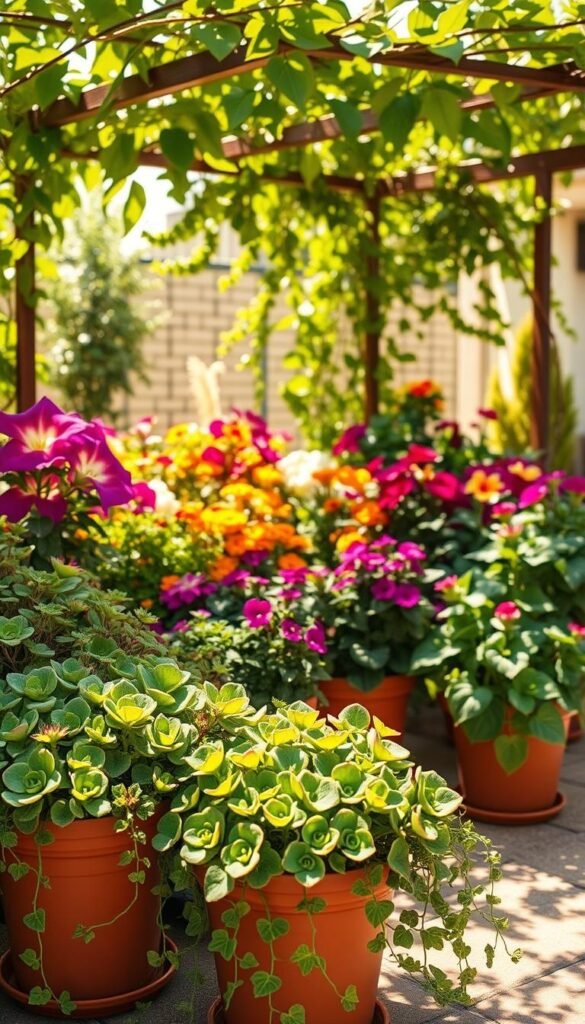
Your plant selections make all the difference when working with limited square footage. Focus on species that deliver multiple seasons of beauty or edible rewards without overcrowding your layout.
Long-Season Bloomers and Compact Varieties
Prioritize plants that work overtime. Rosa ‘Flower Carpet Amber’ blooms for eight months straight, while shrub roses like ‘Lady of Shalott’ deliver color from June through October. These stars ensure your small garden stays lively even as seasons change.
Try these low-maintenance performers:
- Erigeron karvinskianus (daisy-like flowers spring to fall)
- Erysimum ‘Bowles’s Mauve’ (violet blooms for six months)
- Hardy geraniums (colorful groundcover all summer)
Evergreen shrubs like boxwood add winter structure. Pair them with ornamental grasses for year-round texture.
Herbs and Vegetables for Container Gardening
Turn your patio into a productive paradise. Basil and mint thrive in pots, offering fresh flavors and aromatic foliage. Oregano spills beautifully over edges, while sage adds silvery contrast.
For veggies, try space-smart options:
- Cherry tomatoes (‘Tiny Tim’ grows 12″ tall)
- Baby lettuce mixes (harvest leaves weekly)
- Dwarf peppers (‘Lunchbox Red’ fits 8″ pots)
Group plants with similar needs – Mediterranean herbs in sunny spots, leafy greens in partial shade. You’ll enjoy fresh ingredients without sacrificing style.
Embracing Vertical Gardening and Green Walls
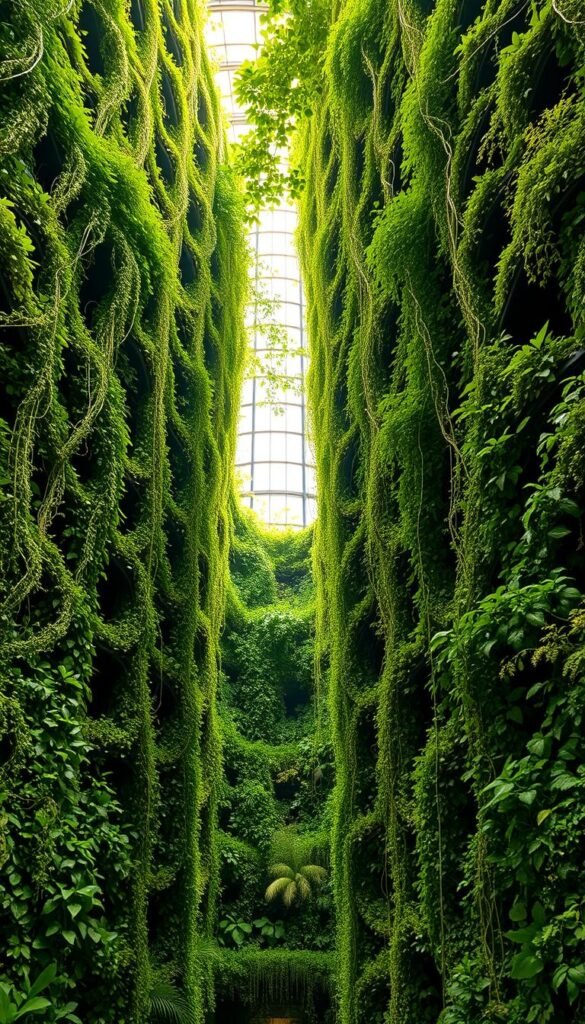
When square footage is scarce, look upward—your vertical surfaces hold untapped potential. By shifting focus from ground space to airspace, you create layered beauty while keeping pathways clear. This approach lets you grow up to three times more greenery without sacrificing style.
Hanging Baskets for Color and Texture
Elevate your design with cascading blooms that double as living decor. Trailing petunias spill over edges like floral waterfalls, while lobelia adds delicate sprays of blue. For foliage contrast, ivy geraniums offer lush greenery with pops of color.
Mix textures for visual drama:
- Velvety purple wave petunias
- Feathery sweet potato vine
- Spiky asparagus fern
Hang baskets at staggered heights near seating areas to frame views. Self-watering systems keep blooms vibrant with minimal effort.
DIY Techniques for Building a Green Wall
Transform blank fences into edible art with modular panels. Start with a weatherproof frame and landscape fabric pockets. Fill them with:
- Compact herbs (thyme, oregano)
- Leafy greens (kale, spinach)
- Colorful annuals to brighten any space
For quick installations, repurpose wooden pallets or shoe organizers. Position taller plants like alliums at the top, letting shorter varieties cascade downward. Add drip irrigation for stress-free maintenance—your living wall stays lush all season.
Mini Garden Ideas for Small Spaces and Compact Yards
Even the most confined outdoor spots can thrive with layered, imaginative designs. By blending ground-level plantings with vertical accents and elevated platforms, you craft depth that tricks the eye. A petite water feature—like a recirculating fountain tucked between ferns—adds movement without hogging precious square footage.
Smart layouts turn limitations into advantages. Try nesting seating within planter boxes or using foldable stools that vanish when not needed. “The secret lies in elements that pull double duty,” notes urban landscaper Mia Tanaka. Her favorite hack? Hanging herb racks that moonlight as privacy screens.
Bold container groupings make statements while saving space. Cluster pots in odd numbers (3s or 5s) with varying heights for drama. For beginners, container gardening offers an easy entry point—mix ornamental kale with trailing ivy in window boxes for instant curb appeal.
Lighting transforms your yard after dark. Solar-powered string lights outline pathways, while LED spotlights highlight architectural plants. Keep hardscapes light-colored to reflect both sunlight and moonlight, making areas feel airier.
Portable elements grant flexibility. Rolling plant caddies let you chase the sun, while modular raised beds adapt as needs change. With these strategies, your compact plot becomes a dynamic retreat that evolves with the seasons.
Creative Container Gardening Techniques
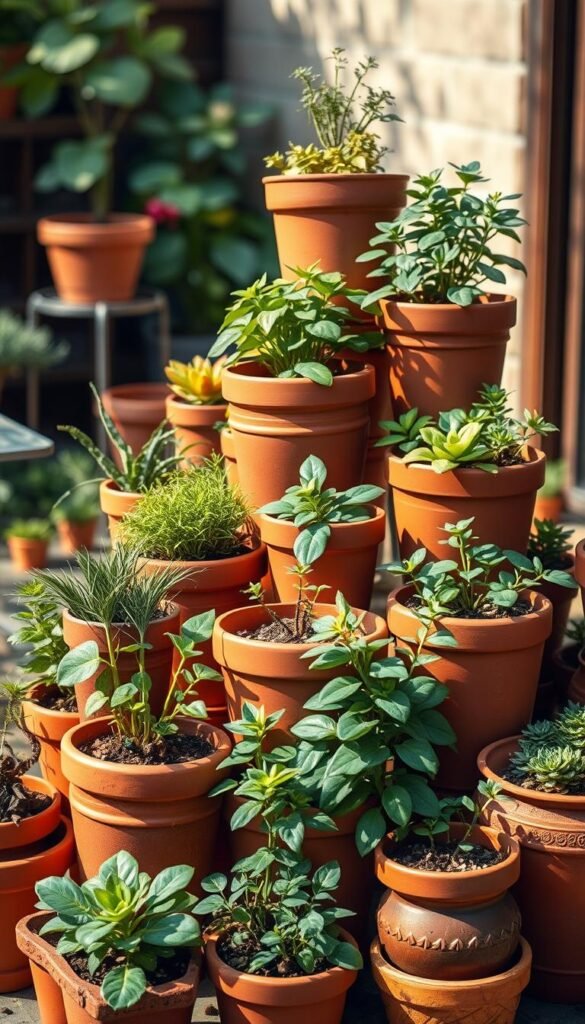
Containers become your canvas when ground space is limited. With clever arrangements and unexpected materials, you can craft living art that serves practical growing needs while dazzling the senses.
Breathing New Life Into Everyday Objects
Terra-cotta pots shine in stacked formations. Try a three-tier planter filled with rainbow blooms—red geraniums at the top, orange marigolds in the middle, and yellow coreopsis cascading below. This vertical display saves floor space while creating a floral waterfall effect.
Your kitchen holds hidden gardening gems. Colanders transform into charming planters for herbs like basil and thyme. Their built-in drainage prevents soggy roots, while the metallic finish adds industrial chic. Paint them cobalt blue for bold contrast or let natural patina develop over time.
Group containers strategically:
- Cluster odd-numbered groupings (3-5 pots) for visual harmony
- Mix heights using stools or overturned crates
- Pair trailing ivy with upright lavender for textural drama
Repurposed items add personality. Try these conversions:
| Household Item | Plant Suggestion | Display Tip |
|---|---|---|
| Rain boots | Pansies | Line walkways |
| Baking sheets | Succulents | Wall-mounted |
| Teapots | Miniature roses | Table centerpiece |
Rotate seasonal flowers to maintain year-round interest. Spring bulbs make way for summer petunias, followed by autumn mums. Your container arrangements stay fresh without requiring new pots each season.
Innovative Raised Beds and Wheelbarrow Gardens
Maximize every inch of your outdoor area with adaptable growing systems. Raised beds solve common planting challenges while adding rustic charm to patios, yards, or awkward corners. Their elevated design prevents waterlogging and lets you control soil quality—no more battling compacted ground.
Enhanced Drainage and Easy Maintenance
These structures slash weeding time by keeping roots contained. A creative raised bed concept using cedar planks or stacked stones creates instant visual appeal. For mobility, repurpose old wheelbarrows as rolling planters—perfect for herbs or cascading flowers that follow the sun.
Build beds 10-12 inches tall to reduce bending. Fill them with nutrient-rich soil for thriving veggies or blooms. Follow this step-by-step raised bed guide to construct durable frames that last seasons. Add hardware cloth underneath to block weeds while letting roots breathe.
Portable designs adapt as your needs change. Move wheelbarrow planters to highlight seasonal colors or protect tender greens from frost. With smart layouts and low-maintenance materials, you’ll spend less time working and more time enjoying your vibrant oasis.

